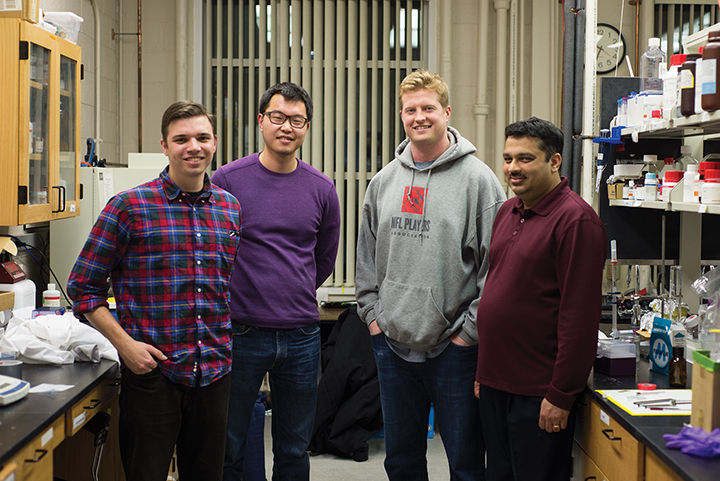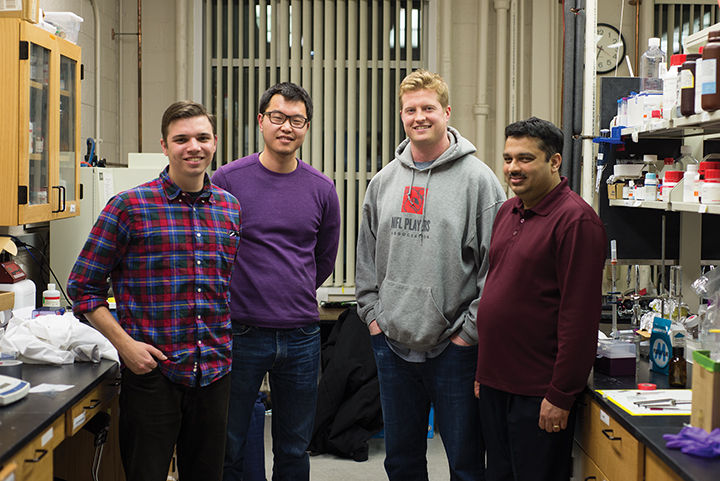In 2010, Matt Furstenburg made the biggest catch of his career for the Terrapins football team: a 53-yard catch against Clemson.
Days later, the then-sophomore tight end’s gloves were worn and lost their stick, forcing him to replace them continually.
“I noticed I would go through gloves every few days,” said Furstenburg, who graduated in 2012 and is a former Baltimore Ravens tight end. “They’re pretty expensive. They’re about $20 to $60, average price range.”
That sparked the idea that led to a collaboration between Furstenburg, university professor Srinivasa Raghavan, entrepreneur Harry Geller, 2014 alumnus Kevin Diehn, 2014 alumnus Chanda Arya and senior chemical engineering major Zach Rom and the solution to Furstenburg’s equipment woes: Grip Boost gel.
The gel, which can be applied to a receiver’s glove, increases the glove’s longevity by forming a thin film around it that makes it tacky and prevents wear and tear. The gel takes about 15 to 20 seconds to dry.
“It’s an interesting alignment of football background from Matt — knowing the problems in football — and seeing what kind of chemical solutions from Maryland’s chemical engineering department can put together,” Arya said.
When the gel is applied, Raghavan said, a person will not see any residue sticking on the football or gloves. The Grip Boost team, Furstenburg said, believes the gel will satisfy all of conditions of the National Football League, college and high school rules.
Furstenburg said the gel is geared toward high school and university football players due to its affordability. Users would get about 60 applications out of the 2-ounce bottle.
The product, now offered on Amazon and GripBoost.com for $10.99, is already starting to circulate in local and professional football spheres. Furstenburg said local high school football teams, Under Armour, the Baltimore Ravens and this university’s football team have all used and tested the gel.
“We did surveys with the University of Maryland football team and they were all very, very positive,” Arya said.
Despite the gel’s success — the Grip Boost team reported they sell a couple hundred units a month — the team said the process of creating and finalizing the product was not simple and took about two years to complete.
Furstenburg initially pitched the idea in 2011 for a product that could enhance football gloves to Geller, an entrepreneur in residence at this university’s Dingman Center for Entrepreneurship.
“There really is a need for something to extend the lives of football gloves,” Geller said.
After their interaction, Geller helped connect Furstenburg to Raghavan, a chemical and biomolecular engineering professor, in July 2012.
Raghavan said he was immediately interested in the idea of developing a product to combat glove deterioration and realized his lab had created a material from a previous project focused on clotting blood that could become key to the product’s development.
“It occurred to me that [this material] could be a starting point for our search for a material that could adhere to gloves and make them more sticky,” Raghavan said.
Diehn and Arya, Raghavan’s students at the time, heard about the project from their professor and worked to create, develop and finalize the gel with support from undergraduate researchers.
The team is now working to expand and grow, and with a $100,000 Maryland Innovation Initiative grant it received in October, the next challenge is to find a way to mass-produce the gel.
“We’ve made this in the lab, on the lab scale, so we are trying consider what is the cheapest, best, efficient methods to make this on a much larger scale,” Arya said.
The next phase, Raghavan said, is taking the university-patented product to the big leagues. He said he hopes to see the big corporate players, such as Under Armour and Nike, license or buy the product in the future.
“It’s gone from an idea in need of a solution to a real solution being sold,“ Raghavan said. “This is an example that’s reached the marking … I don’t know of many other technologies that have gone so far so quickly.”
CORRECTION: In a previous version of this story, it incorrectly stated that the Grip Boost team sells a couple thousand units each month. They sell a couple hundred units each month. Also, one photo incorrectly credited a photo to Chanda Arya, but it should have been Faye Levine. The article has been updated to reflect the change.
From right to left: Kevin Diehn, Matt Frustenburg, former Maryland Football player, and Srini Raghavan, the chemical engineering professor that assisted the group during the project





